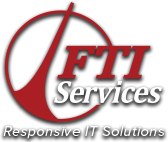Burbank IT Support Provider Explains Cloud Security Assessments
Cloud security is a business imperative. While platforms like AWS and Microsoft Azure offer robust infrastructure, relying solely on their built-in protections is a dangerous oversimplification. True security demands vigilance, customization, and regular evaluation.
According to IBM’s 2025 Cost of a Data Breach report, cloud-related breaches now cost companies an average of $5.17 million. This figure reflects how quickly misconfigured systems and outdated access controls can spiral into full-blown crises.
| “Cloud security isn’t a one-time setup; it’s a living system. If you’re not assessing it regularly, you’re not securing it,” says Jason Cary, VP of Sales at FTI Services |
In this blog, we’ll break down why cloud security assessments are essential for modern businesses, how they help uncover hidden vulnerabilities, and what steps you can take today to strengthen your cloud posture.
Discover how our Burbank IT support team simplifies your next review with a practical cloud security assessment checklist.
Why Cloud Security Risks Keep Escalating
Cloud platforms have matured quickly. But in many companies, security has not kept up. Multi-cloud environments are now the norm. 92% of enterprises follow a multi-cloud strategy, which adds more access points and integration layers.
Without tight controls across each platform, gaps emerge quickly. You might be using multiple cloud platforms, working across departments, or expanding faster than your IT can support. That’s when cracks form.
- Cloud adoption outpaces secure configuration: It’s easy to spin up cloud services. It’s harder to secure them properly. Many teams forget to adjust default settings or clean up old user accounts.
- Multi-cloud and hybrid environments add complexity: Using AWS, Microsoft 365, and private servers together? That’s common. But it also means more gaps between systems.
- Real-world consequences: The most common problems include misconfigured storage buckets, weak IAM (identity and access management) rules, and missing compliance settings.
What Is a Cloud Security Assessment and What Does It Cover
87% of firms use cloud-based solutions, but many don’t pay attention to security. A cloud security assessment is a full review of how your cloud systems are protected. It checks if your settings, tools, and policies can handle today’s security risks. It’s not just a scan or checklist. It’s a strategic health check for your environment.
These are the key areas the assessment should cover:
- Cloud security risk assessment: Identify potential risks across your cloud platforms. This includes known vulnerabilities, open access points, and misconfigured tools.
- Access control: Who has access to your systems, and how is that access granted, removed, and reviewed?
- Data encryption and storage practices: Are you encrypting data at rest and in transit? Where is your data stored, and is it protected?
- Infrastructure security in cloud computing: Review how your cloud systems are designed. Are servers isolated? Are firewalls and rules configured correctly?
- Logging and monitoring setup: Good logging helps you detect issues early. The assessment should look at what’s being logged and whether alerts are being reviewed.
- Policy compliance and enforcement: Are your systems following internal policies and external regulations like HIPAA, PCI DSS, or GDPR?
Every organization’s environment is different. That’s why the assessment must be tailored to your setup and risk tolerance.
Key Triggers for Running a Cloud Risk Assessment
Timing matters. Certain changes in your organization should prompt an immediate cloud risk assessment. These are the most common scenarios:
- Post-migration review: After moving to the cloud or switching platforms, it’s important to check for any missed configurations or new exposures.
- Compliance or audit readiness: If you need to meet industry regulations or pass an audit, an assessment will help you prepare.
- Major organizational changes: Mergers, acquisitions, layoffs, or staff changes often lead to access gaps or neglected systems.
- New technology rollouts: Adding AI, containers, or serverless tools? These bring new risks. An assessment helps confirm they’re securely deployed.
If you’ve gone more than 12 months without an assessment, you’re already overdue.
Benefits of Running Regular Cloud Assessments
Regular cloud assessments do more than just reduce risk. They also improve how your team manages cloud systems. They help align your IT investments with your business goals. With 64% of organizations citing data loss and privacy as top concerns, these reviews are not optional.
- Reduces your attack surface: Find and fix weaknesses before someone else discovers them.
- Lowers response time and costs: With fewer unknowns, your team can resolve problems faster.
- Creates clear ownership: You’ll know who owns which systems, who has access, and who manages which risks.
- Keeps you compliant: Stay ahead of audits and reduce your chances of non-compliance fines.
- Proves your security strategy works: You can validate that your policies and protections are doing their job.
Without regular assessments, cloud security becomes reactive. You’re always one step behind. Assessments keep your team in control.
10-Point Cloud Security Assessment Checklist

Use this cloud security assessment checklist to guide your internal review or prepare for a third-party evaluation. Each point must be reviewed carefully and customized to your environment.
- Define scope and inventory cloud assets: Know what you’re assessing. List all cloud platforms, tools, users, and assets in your environment.
- Evaluate existing security controls: Document which protections are already in place and if they are functioning correctly.
- Run configuration and vulnerability scans: Use tools to identify known weaknesses in cloud workloads, networks, and services.
- Validate IAM policy enforcement: Ensure that users only have access to the resources they need, and that rules are enforced automatically.
- Test encryption and data backup settings: Confirm that sensitive data is encrypted, and that backups are complete and stored securely.
- Run a cloud risk assessment checklist: Focus on exposure, misconfigurations, external threats, and gaps between tools.
- Perform access and logging audits: Check who accessed what, when, and whether those actions are being logged properly.
- Compare against compliance baselines: Evaluate your setup against frameworks like NIST, ISO 27001, or specific regulations.
- Create a remediation roadmap: Document what needs fixing, who owns each task, and the expected completion dates.
- Schedule continuous reviews: Build recurring assessments into your calendar so nothing falls behind.
This checklist gives you a framework. A qualified partner can help you apply it correctly to your unique environment.
Choosing the Right Cloud Assessment Tools and Partners
There are hundreds of cloud assessment tools on the market. Some are helpful. Others create more noise than clarity. Knowing what to use and when can make or break your assessment.
- Manual vs. automated scanning: Automated tools speed up detection. But they often miss context. Manual review is slower but provides deeper insight.
- Tool-only approaches fall short: Tools don’t fix problems. They report them. Your team or vendor still needs to prioritize and resolve each issue.
- Work with engineers, not just software: The most effective assessments combine scanning tools with skilled professionals who know your platforms.
When choosing a partner, ask about:
- Speed of results: How fast will you receive findings? Days, weeks?
- Depth of visibility: Does the assessment look at accounts, APIs, and third-party integrations?
- Clarity of prioritization: Will you get a clean list of critical, moderate, and low-risk items?
- Platform experience: Are they certified with AWS, Microsoft, or Google?
Cloud tools evolve quickly. So should your assessment partner.
How to Build a Proactive Cloud Security Strategy
One cloud security risk assessment is not enough. A solid security strategy requires ongoing checks, updates, and accountability.
Think of this cycle:
- Assessment: Identify what’s wrong or at risk.
- Remediation: Fix what’s broken. Close gaps. Update policies.
- Monitoring: Set up alerts and review dashboards to catch changes or new risks.
Use assessment results to guide your budget. Prove what needs funding. Use findings to create a roadmap that links tech needs to business goals.
The goal isn’t just to stay secure. It’s to make security part of how your business grows and responds to change.
Comparing Common Cloud Assessment Triggers and Benefits
Certain events should trigger a cloud assessment. But the benefits you gain depend on when and how you act. Use the table below to identify which scenarios apply to your business.
| Cloud Event or Trigger | Assessment Benefit |
| Post-cloud migration | Identify misconfigurations from rapid setup |
| Compliance audit preparation | Ensure you meet regulatory and policy requirements |
| Platform expansion or new tool rollout | Check for new gaps created by new technologies |
| Staff turnover or role changes | Remove stale accounts and update access rules |
| Annual security check-up | Validate your protections still meet today’s threats |
Make Cloud Assessments Work for You with Our IT Support Services in Burbank
Cloud security assessments help you find what’s exposed, fix it, and build long-term protection. You don’t need to handle this alone. FTI Services brings over 38 years of IT experience to guide you through every step.
We support more than 7,500 users, maintain a 95%+ client retention rate, and resolve 94% of issues on the first call. Our engineers don’t just report problems, they fix them.
Contact our IT support specialists in Burbank today to schedule your assessment and discover what’s truly at risk in your environment.




